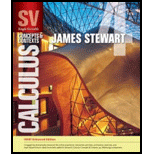
Concept explainers
a.
Find parametric equations for the set of all points P .
a.
Answer to Problem 34RE
(a−acos2θ,2atanθ−asin2θ)
Explanation of Solution
Given information:
Find parametric equations for the set of all points P determined as shown in the figure such that |OP|=|AB| .(This curve is called the cissoid of Diocles after the Greek scholar Diocles, who introduced the cissode as a graphical method for constructing the edge of a cube whose volume is twice that of a given cube.)
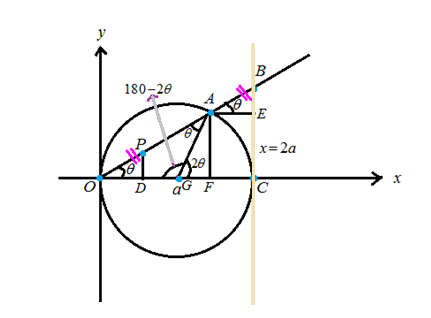
Calculation:
Consider the figure
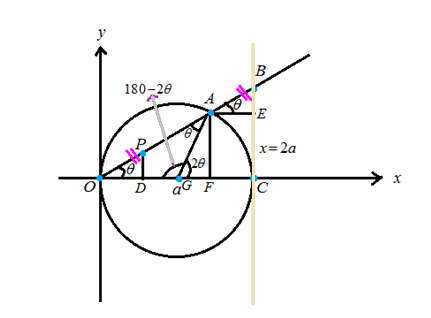
Whereas OG&GA are radii of the circle radius a . So OG&GA are congruent and so their opposite angles OAG&AOG are congruent.
Hence OAG=AOG=θ .
For the triangles ABE&ODP , the sides |OP|=|AB| and lines BE‖PD (these lines are perpendicular to the x−axis ) so the angles BAE&POD are congruent.
Hence BAE=POD=θ .
Consider the triangle OBC to find the coordinates of the point B .
Hence OC=2a (diameter of the circle) and BOC=θ , we have
tanθ=BC2aBC=2atanθ
The x -coordinate of the point B is 2a and the y− coordinates is 2atanθ .
Hence the point B=(2a,2atanθ) .
To find the point A , we need to determine the distances AF&OF .
In the triangle OAG , sum of the angles are
θ+θ+AGO=180°AGO=180°−2θ
We know that
AGO+AGF=180°180°−2θ+AGF=180°AGF=2θ
Now consider the triangle AGF, get
sin2θ=AFAG=AFaAF=asin2θ
And
cos2θ=GFAG=GFaGF=acos2θ
The x− coordinate of the point A is
OG+GF=a+acos2θ
The y− coordinate of the point A is AF=asin2θ .
Hence, the point A=(a+cos2θ,asin2θ) .
Find the distance AE&BE:
To get the distance AE , we need to subtract the x -coordinate of A from the x -coordinate of B .
AE=2a−(a+acos2θ)=a−acos2θ
To get the distance BE , we need to subtract the y -coordinate of A from the y -coordinate of B .
BE=2atanθ−asin2θ .
The triangles ABE&OPD are congruent whereas the sides OP,AB are equal and the angles BAE&POD are equal.
Hence, in these two triangles ABE&OPD the corresponding sides AE,OD are equal and BE,PD are equal.
AE=OD=a−acos2θ,BE=PD=2atanθ−asin2θ
Hence, the required coordinates of the point P is (a−acos2θ,2atanθ−asin2θ) .
b.
Use the geometric description of the curve to draw a rough of the curve by hand.
b.
Answer to Problem 34RE
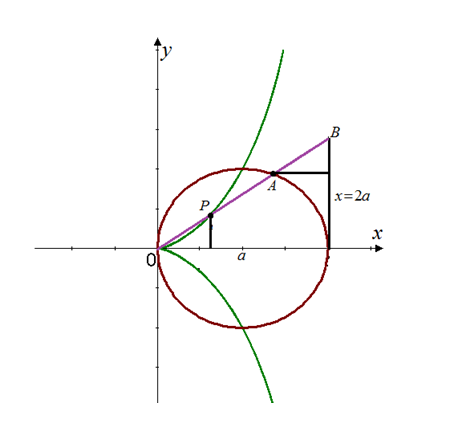
Explanation of Solution
Given information:
Use the geometric description of the curve to draw a rough of the curve by hand. Check your work by using the parametric equations to graph the curve.
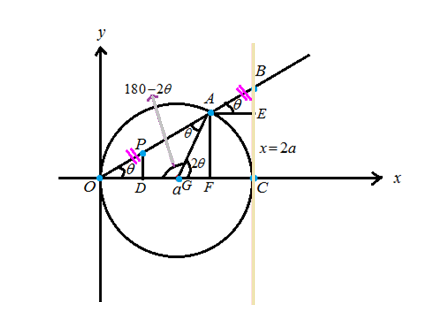
Calculation:
Draw the curve represented by the parametric equations
x(θ)=a−acos2θ,y(θ)=2atanθ−asin2θ .
This curve is known as cissoids of Diocles.
The graph of the curve is shown below:
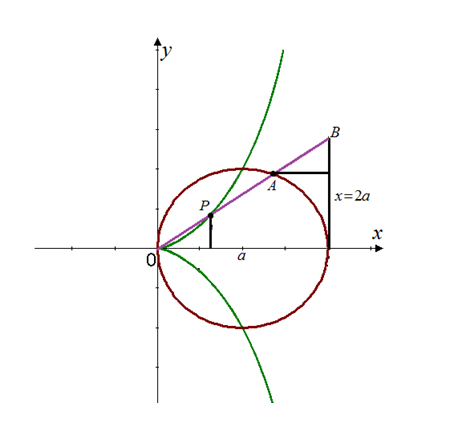
Hence, the result is plotted.
Chapter 1 Solutions
Single Variable Calculus: Concepts and Contexts, Enhanced Edition
- 1. A bicyclist is riding their bike along the Chicago Lakefront Trail. The velocity (in feet per second) of the bicyclist is recorded below. Use (a) Simpson's Rule, and (b) the Trapezoidal Rule to estimate the total distance the bicyclist traveled during the 8-second period. t 0 2 4 6 8 V 10 15 12 10 16 2. Find the midpoint rule approximation for (a) n = 4 +5 x²dx using n subintervals. 1° 2 (b) n = 8 36 32 28 36 32 28 24 24 20 20 16 16 12 8- 4 1 2 3 4 5 6 12 8 4 1 2 3 4 5 6arrow_forward= 5 37 A 4 8 0.5 06 9arrow_forwardConsider the following system of equations, Ax=b : x+2y+3z - w = 2 2x4z2w = 3 -x+6y+17z7w = 0 -9x-2y+13z7w = -14 a. Find the solution to the system. Write it as a parametric equation. You can use a computer to do the row reduction. b. What is a geometric description of the solution? Explain how you know. c. Write the solution in vector form? d. What is the solution to the homogeneous system, Ax=0?arrow_forward
- 2. Find a matrix A with the following qualities a. A is 3 x 3. b. The matrix A is not lower triangular and is not upper triangular. c. At least one value in each row is not a 1, 2,-1, -2, or 0 d. A is invertible.arrow_forwardFind the exact area inside r=2sin(2\theta ) and outside r=\sqrt(3)arrow_forwardA 20 foot ladder rests on level ground; its head (top) is against a vertical wall. The bottom of the ladder begins by being 12 feet from the wall but begins moving away at the rate of 0.1 feet per second. At what rate is the top of the ladder slipping down the wall? You may use a calculator.arrow_forward
- Explain the key points and reasons for the establishment of 12.3.2(integral Test)arrow_forwardUse 12.4.2 to determine whether the infinite series on the right side of equation 12.6.5, 12.6.6 and 12.6.7 converges for every real number x.arrow_forwarduse Cauchy Mean-Value Theorem to derive Corollary 12.6.2, and then derive 12.6.3arrow_forward
 Calculus: Early TranscendentalsCalculusISBN:9781285741550Author:James StewartPublisher:Cengage Learning
Calculus: Early TranscendentalsCalculusISBN:9781285741550Author:James StewartPublisher:Cengage Learning Thomas' Calculus (14th Edition)CalculusISBN:9780134438986Author:Joel R. Hass, Christopher E. Heil, Maurice D. WeirPublisher:PEARSON
Thomas' Calculus (14th Edition)CalculusISBN:9780134438986Author:Joel R. Hass, Christopher E. Heil, Maurice D. WeirPublisher:PEARSON Calculus: Early Transcendentals (3rd Edition)CalculusISBN:9780134763644Author:William L. Briggs, Lyle Cochran, Bernard Gillett, Eric SchulzPublisher:PEARSON
Calculus: Early Transcendentals (3rd Edition)CalculusISBN:9780134763644Author:William L. Briggs, Lyle Cochran, Bernard Gillett, Eric SchulzPublisher:PEARSON Calculus: Early TranscendentalsCalculusISBN:9781319050740Author:Jon Rogawski, Colin Adams, Robert FranzosaPublisher:W. H. Freeman
Calculus: Early TranscendentalsCalculusISBN:9781319050740Author:Jon Rogawski, Colin Adams, Robert FranzosaPublisher:W. H. Freeman
 Calculus: Early Transcendental FunctionsCalculusISBN:9781337552516Author:Ron Larson, Bruce H. EdwardsPublisher:Cengage Learning
Calculus: Early Transcendental FunctionsCalculusISBN:9781337552516Author:Ron Larson, Bruce H. EdwardsPublisher:Cengage Learning





